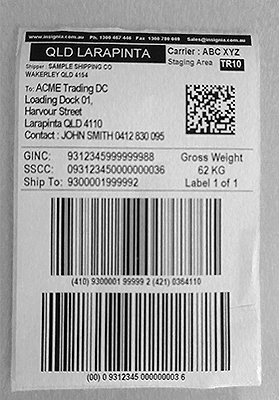ALC and GS1 unveil new label standards to ensure efficient freight movements across multi-leg supply chains
The Australian Logistics Council (ALC) and GS1 Australia have launched the new Australian Transport Standards for Freight Labelling and EDI at the ALC Forum in Sydney today.
Developed by the ALC Supply Chain Standards Work Group, the new standards include the Australian Freight Labelling Guideline and the Australian Transport EDI User Guides to create a common label format for transporting freight and a common file format for data transfer throughout the transportation process.
Designed to instruct the industry on how to physically identify and label freight units, thus creating an efficient and uniform transport management process from origin to destination, the Australian Freight Labelling Guideline is based on the GS1’s global supply chain standards and best practice.
The Australian Transport EDI User Guides were designed to match the labelling changes and ensure the necessary data exchange occurs.
“The Australian transport industry’s freight system is at the heart of our economy,” GS1 Australia trade and transport industry manager Bonnie Ryan says, who unveiled the new standards with ALC managing director Michael Kilgariff.
“The adoption of the Australian Transport Standards for Freight Labelling and EDI will give us the opportunity to improve freight efficiency and better connect all modes of transport in the Australian transport and logistics sector,” Ryan says.
Taking a step further, Kilgariff says the launch is the beginning of an industry-wide process shift from manual to full automation.
“This new roadmap will be a game changer in the efficiency, interoperability, visibility and productivity of freight movement across the supply chain,” Kilgariff says.
Kilgariff predicts the implementation of the new standards will support the logistics industry’s goal of increasing its efficiency by one per cent and therefore boost the Australian GDP by $2 billion.
However, critical to that growth is the effective movement of freight through multi-leg supply chains, an area the new standards hope to address.
 |
|
An example of the new labelling system.
|
The changes allow for a single label format to identify freight as it passes from leg to leg, thanks to a Serial Shipping Container Code (SSCC).
According to GS1 the “SSCC is made up of a GS1 Company Prefix, identifying the company that created the logistic or transport unit and, a Serial Reference number, uniquely identifying each unit.”
“Goods can be tracked seamlessly as they travel through the supply chain, from business to business and ultimately to consumers,” the company says.
“Answers to important ‘what’, ‘where’ and, ‘when’ questions help to meet demands for accurate, detailed visibility and shipment traceability information.”
GS1 says this means freight does not need to be relabelled throughout the shipping process; different couriers can use a single tracking identifier; and a new automated future is possible.
Sentiment backed by the chair of the ALC Supply Chain Standards Work Group and eCommerce Manager for OneSteel David McNeil.
“The labelling and EDI initiative provides an innovative and effective integration roadmap for the Australian Transport & Logistics Industry, now and into the future,” McNeil says.
“It will be of benefit to all Australian businesses to work together seamlessly and efficiently to grow our economy.”
The new standards will also be joined by an Australian Industry Glossary for reference to industry and GS1 terminology.
Industry members can request a copy of the guidelines from the GS1 website here.


